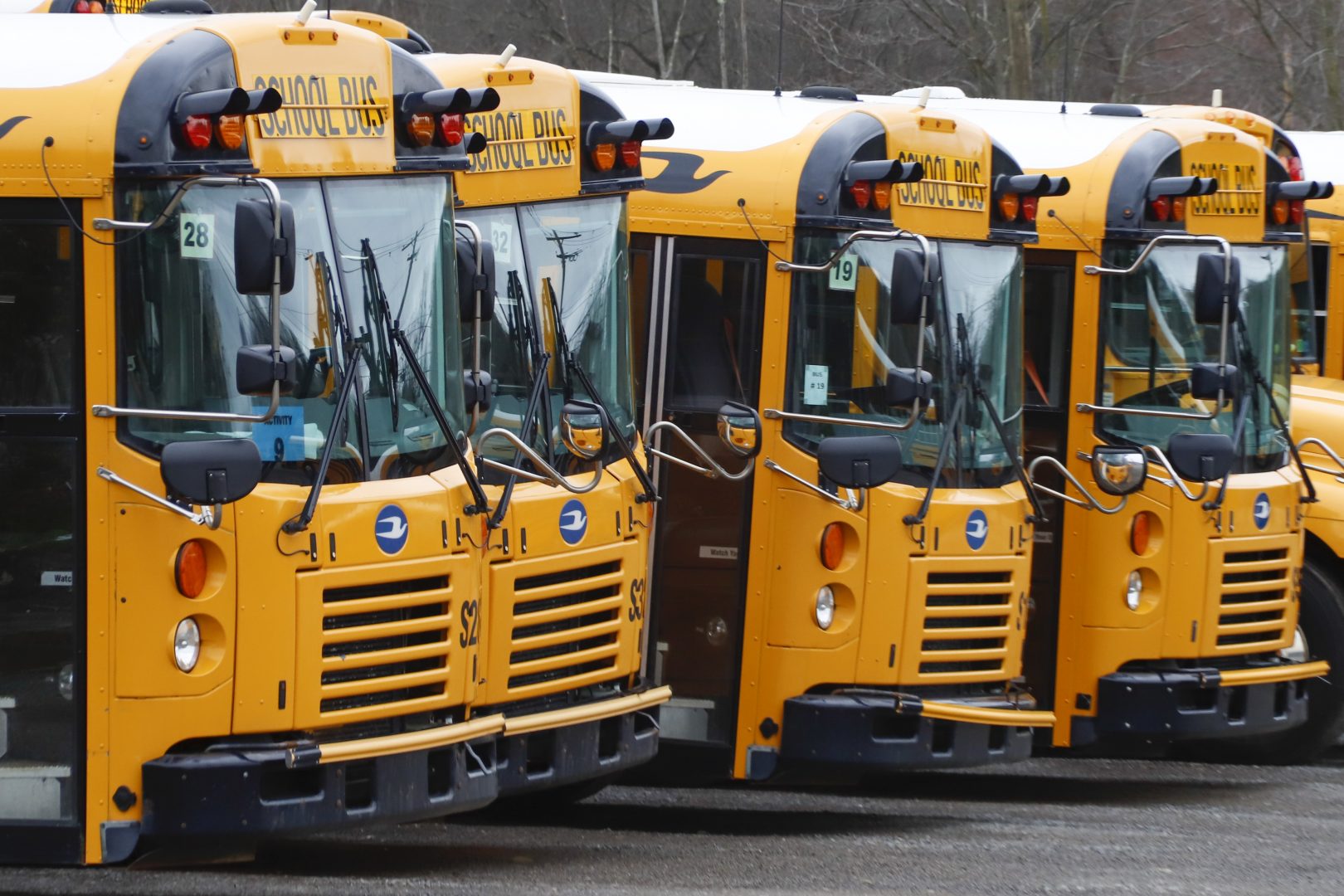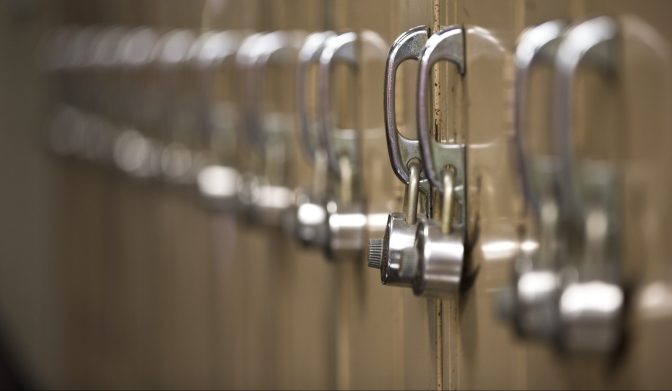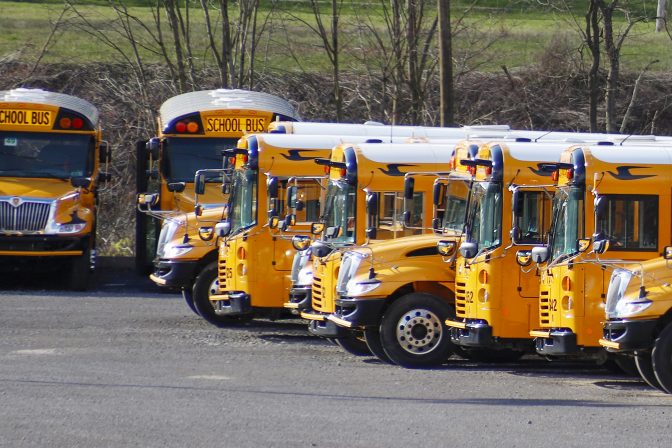
Parked school buses are lined up at the storage area while they are idled during school closings due to the COVID-19 and coronavirus outbreak, Monday, March 30, 2020, in Zelienople, Pa.
Keith Srakocic / AP Photo

Parked school buses are lined up at the storage area while they are idled during school closings due to the COVID-19 and coronavirus outbreak, Monday, March 30, 2020, in Zelienople, Pa.
Keith Srakocic / AP Photo

Keith Srakocic / AP Photo
Parked school buses are lined up at the storage area while they are idled during school closings due to the COVID-19 and coronavirus outbreak, Monday, March 30, 2020, in Zelienople, Pa.
It’s been five months since school districts, parents, and advocacy groups made their final arguments in a case that could transform how Pennsylvania funds its public schools.
The lawsuit, which the parties first filed in 2014, argues that the state’s funding of K-12 education is inadequate to the point that it violates the state’s constitution.
Dan Urevick-Ackelsberg, a lead attorney for the plaintiffs, is one of many people still waiting for a decision.
“There’s really nothing to read into other than that it’s an enormous task,” he said.
The task is twofold: First, based on the state’s constitution, determine what standard of education Pennsylvania owes its public school students. And second, decide whether the current system violates that standard.
There’s no timeline or deadline for Judge Renée Cohn Jubelirer, a Republican, to issue her decision.
Urevick-Ackelsberg said if the plaintiffs win, “knock on wood a thousand times,” the defendants, Pennsylvania’s governor and the leaders of the state Legislature, will almost certainly appeal the decision to Pennsylvania’s Supreme Court. The plaintiffs will do the same if it goes the other way.
“The case will continue as long as there is one respondent disputing our claim that the Pennsylvania funding system is unconstitutional,” said Deborah Gordon Klehr, the executive director of the Education Law Center. Gordon Klehr’s organization, the Public Interest Law Center, and private firm O’Melveny & Myers represent the plaintiffs.
Governor-elect Josh Shapiro and leaders of the state’s Democratic Party have repeatedly voiced their support for increased spending on public education, with a focus on distributing funds more equitably.
As attorney general, Shapiro submitted an amicus brief in support of the lawsuit.
He argued that the state constitution’s education clause requires the General Assembly to fund a public education system that provides all students with “comprehensive, effective, and contemporary education that prepares them for a career and civic life.”
Based on this, he wrote, “the General Assembly is failing its constitutional obligation.”
Shapiro promised to spend more money on public education with a focus on equity during his transition press conference in mid-November.
“To me, opportunity starts in our public school classrooms,” he said. “It means fully funding our schools so that all Pennsylvania children receive a quality education.”

Matt Rourke / AP Photo
Shown are lockers at South Philadelphia High School, Sept. 9, 2013, in Philadelphia.
Seven years after six school districts (including the School District of Lancaster and the Shenandoah Valley School District) , six sets of parents, and two advocacy groups filed their lawsuit in 2014, the trial finally began in Commonwealth Court in November 2021.
Over the course of four months, the plaintiffs argued that Pennsylvania’s school system is so underfunded it violates the state constitution’s education clause, which requires lawmakers to “provide for the maintenance and support of a thorough and efficient system of public education,” as well as its equal protection clause.
At trial, Katrina Robson, a lawyer for the plaintiffs, said the authors chose their words carefully.
“They are words that require more than a bare minimum. Words that require a system that serves all children, not just some,” she said.
Meanwhile, Patrick Northen, an attorney representing GOP House Speaker Bryan Cutler, argued the constitution was deliberately written to not require a “uniform” standard.
“The framers were also worried about a race to the bottom, meaning that rather than elevating lower performing schools to do better, a uniformity clause might cause higher performing schools to weaken their efforts,” he said.
Throughout the trial, funding reform advocates presented examples of what they believe are inadequate and inequitable conditions in rural, urban, and suburban schools.
A social studies teacher in rural southeast Pennsylvania said she used her own money to buy up-to-date lessons since the textbooks in her classroom list Bill Clinton as the current U.S. president.
Recent graduate P. Michael Horvath said his high school in Luzerne County was full of roaches and didn’t prepare him for college, since he rarely had homework and was never assigned a research paper longer than three pages.
Philadelphia’s former superintendent testified that the district couldn’t afford to remediate schools riddled with asbestos and lead paint.
Lawyers for the defendants, which at the time were the leaders of the state’s GOP-controlled legislature and Democratic Gov. Tom Wolf, countered that the plaintiffs had cherry-picked and exaggerated examples.
Pennsylvania has some of the greatest spending gaps in the country between districts, which advocates believe has to do with the way the state distributes money.
The state provides only about a third of public school funding, potentially underfunding its schools by as much as $4.6 billion, by one assessment. The majority of each district’s budget comes from local property taxes, which can vary widely based on the wealth of a community.
These spending gaps have also been shown to translate to opportunity gaps between Black and white students.

Keith Srakocic / AP Photo
School buses are parked at a depot Thursday, April 9, 2020, in Zelienople, Pa.
Zahava Stadler, an education researcher focused on school finance equity issues, said Pennsylvania is interesting because of its lack of policy.
The state didn’t have a formula to allocate funding to schools until 2016, and instead largely distributed funds to districts based on how many students they enrolled 30 years ago.
The new formula is student-based, uses up-to-date enrollment, and assigns additional dollars to students who are more costly to educate, such as students who are living in poverty, do not speak English as their first language, or have an individualized education plan or IEP.
Stadler said the formula is “pretty good”; the problem is it only applies to new — not pre-existing — spending.
About $700 million (11%) of the state’s education funding flowed through the formula in 2020, while $5.5 billion was distributed using the outdated system. Since then, Wolf has increased the amount of money distributed through the formula to roughly $1.4 billion.
“The fact that the state isn’t actually using the formula to govern most of its money means that it’s preserving the harm that it was trying to correct,” Stadler said.
She said the school funding situation in Pennsylvania is made worse by the absence of rules when it comes to how much money districts can generate at the local level.
Half of states have a floor and almost half have a ceiling, she said. More than half have a threshold where you need to consult voters before raising taxes. “Pennsylvania has none of that,” Stadler said.
As a result, she said, local tax rates are all over the place and school systems are “at the mercy” of what their communities can afford. Places with less property wealth typically overtax themselves to make their budgets work, while places with high property wealth raise money more easily and may end up with more than they need.
Stadler said this is something lawmakers need to address and can take on ahead of the verdict.
She said they can look at other states for examples, including Wyoming, which has strict tax limits that don’t “leave room for inequity to come in from the local level,” and Vermont, which has a unique pooling system.
If the judge rules in the plaintiffs’ favor, attorney Urevick-Ackelsberg hopes the decision will make clear the standard of education every child in Pennsylvania is entitled to.
“If we are so lucky, it’s unlikely that the decision is going to give an exact solution,” he said.
Stadler, the funding expert, said the language the case hinges on is interesting because the phrasing “thorough and efficient” is the same on both sides of the Pennsylvania-New Jersey border.
While the Commonwealth only picked up the question recently, the meaning has been somewhat settled in the Garden State for decades due to a series of New Jersey Supreme Court cases, known as the Abbotts, that date back to the 1970s.
In 1990, the New Jersey Supreme Court upheld a lower court decision that found the state’s funding law unconstitutional when applied to children in more than two dozen “poorer urban” school districts.
The Court directed the state’s legislature to amend or enact a new law to assure funding for the districts “substantially equivalent” to that in wealthy suburban districts and “adequate” to provide the programs necessary to address the challenges children often face in poor cities.
“I think the New Jersey line of cases is a great demonstration of what it means to understand ‘adequate’ relative to the opportunities that the best resourced community would want and provide for its children,” Stadler said.
If Pennsylvania was held to the same clear standard as New Jersey, Stadler believes Pennsylvania would distribute significantly more funding per pupil in high-poverty districts than in low-poverty districts.
Petitioners and advocates said they’re encouraging Shaprio and leaders of the state’s Democratic Party to act ahead of a ruling.
Gordon Klehr, with the Education Law Center, said there’s no reason to wait.
“We hope that the governor will work with the legislature to allocate sufficient funds to the districts that need it most and they can do that today,” she said.
Stadler said lawmakers should focus on two things: Moving more money through the state’s formula and passing laws that govern local school tax rates to prevent inequity.
“There’s no reason that fairness and equity can’t run ahead of a court mandate,” she said. “They could even beat the courts to the finish line.”

Get insights into WITF’s newsroom and an invitation to join in the pursuit of trustworthy journalism.
The days of journalism’s one-way street of simply producing stories for the public have long been over. Now, it’s time to find better ways to interact with you and ensure we meet your high standards of what a credible media organization should be.